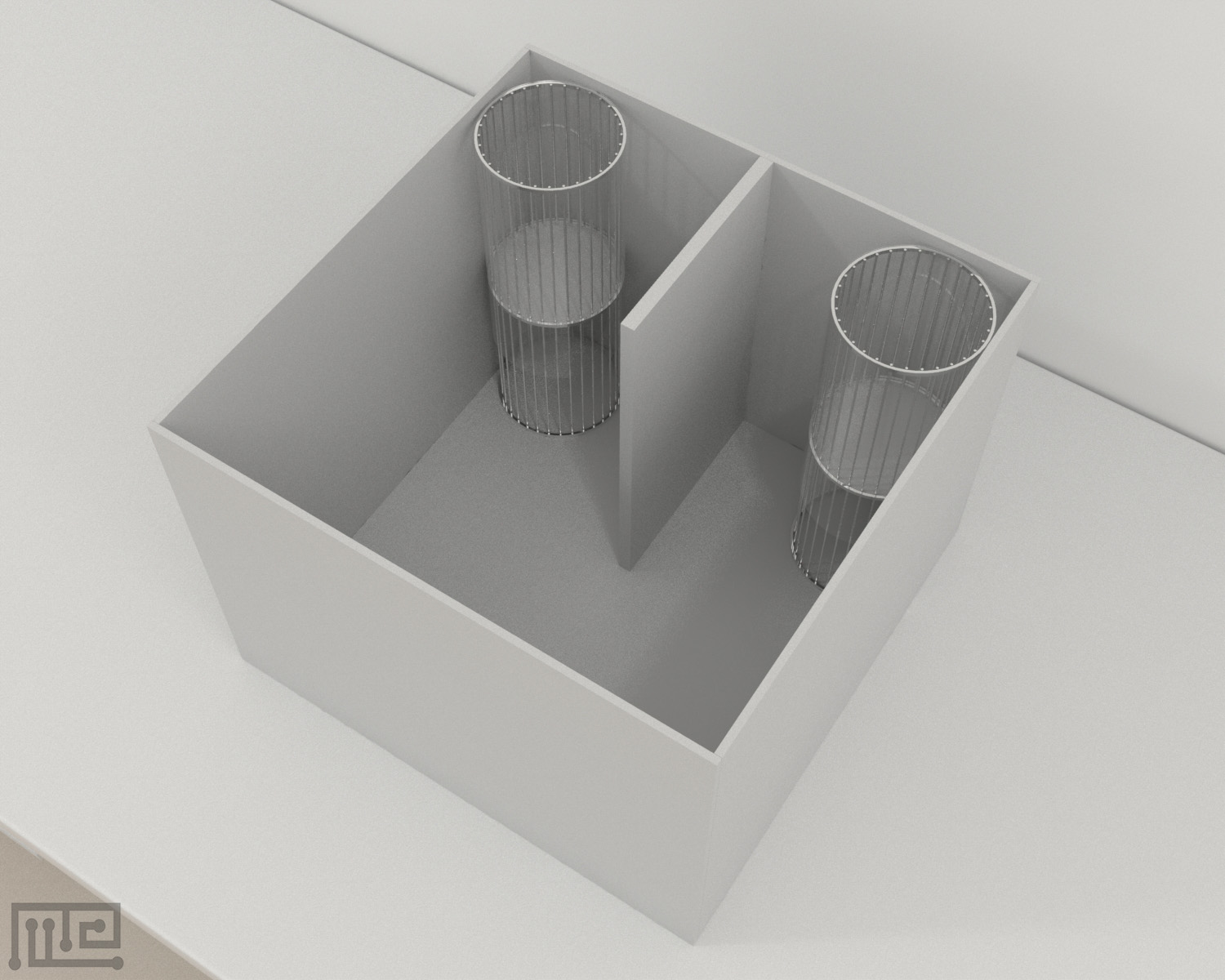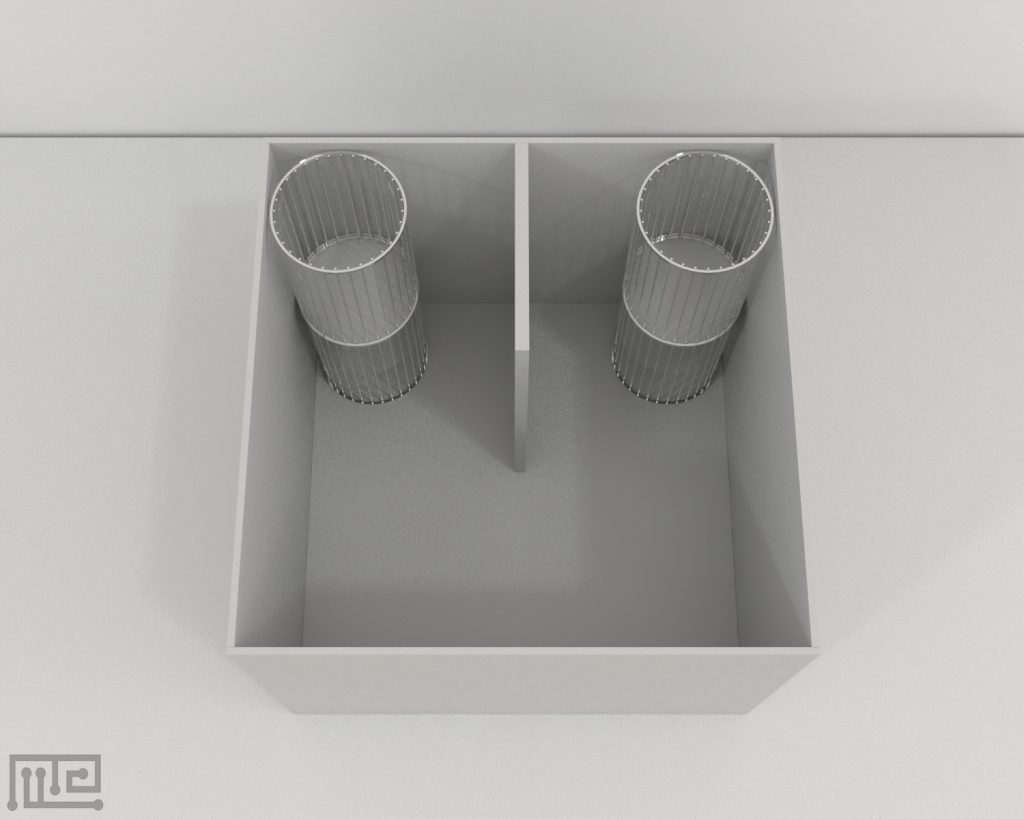The U Shaped 2 Choice Field was used to read out behavioral states of sociability in rodents in an experiment by Eun-Hwa Lee et al.(2018). It can be used to measure animal’s behavioral responses to two contrasting orsimilar options, such as (i) a social target versus an inanimate object, (ii) a new stranger versus an earlier stranger, and (iii) a novel animal (a non-mate) versus a cage-mate (a familiar animal).
The U-shaped two-choice field is a modified open field that is partially partitioned with a wall to the central point, so that a ‘U-shaped’ field that contains two closed quadrants and two open quadrants of the same size is formed.
Mazeengineers offers the U Shaped 2 Choice Field.
Price & Dimensions
Mouse
$ 1890
+S&H- Width of field: 45cm
- Depth of field: 45cm
- Height of field: 35cm
- Width of partitioning wall: 20cm
- Height of partitioning wall: 35cm
- Diameter of circular grid cages: 12cm
- Height of circular grid cages: 33cm
- Thickness of field panel: 1cm
Rats
$ 1990
+S&H- Width of field: 59.8cm
- Depth of field: 59.8cm
- Height of field: 46.5cm
- Width of partitioning wall: 26.6cm
- Height of partitioning wall: 46.5cm
- Diameter of circular grid cages: 15.9cm
- Height of circular grid cages: 43.8cm
- Thickness of field panel: 1.33cm
Are you an academic scientist and creator?
Learn how your lab can tech transfer this and similar devices from your lab to industry.
Documentation
Introduction
The U Shaped 2 Choice Field is a modified form of open field designed to study social behavior in rodents. Aberrant social behavior is a characteristic of many neuropsychiatric and neurodegenerative disorders like depression, anxiety, schizophrenia, autism, and social phobias (Lee, Park, Lee & Han, 2018). Mice are social creature, so they are extensively used as a model in studying social behaviors (Lee, Park, Lee & Han, 2018, Moy et al., 2004) and neuropathological mechanisms of different psychiatric illnesses (Seo et al., 2012, Kim & Han, 2016).
The U Shaped 2 Choice Field is a simple apparatus used to investigate social behavior in rodents. It is composed of a rectangular field partially divided through a wall projecting from one side of the field to the center, thus creating two open and two closed quadrants. The apparatus provides an opportunity to assess the subject’s social behavior and preference when provided with similar or different social targets. The U Shaped 2 Choice Field can be used to quantitate different social behaviors like social interaction, social novelty recognition and social preference to study symptoms and neuropathological mechanisms in mice models of depression, anxiety and autism, etc. (Lee, Park, Lee & Han, 2018, Moy et al., 2004, Kim & Han, 2016, Park et al., 2014).
Other apparatuses used in the evaluation of social behavior in rodents include the Sociability Chamber, The Social Reward Chamber, and the Visual Burrow System.
Apparatus and Equipment
The U Shaped 2 Choice Field is composed of an open rectangular field measuring 45 cm in width, 45 cm in-depth, and 35 cm in height. This open field is modified by a wall (25 cm in width and 45 cm in height) that projects from one side of the field to the center, dividing the field into two open and two closed quadrants of the same size. The apparatus is also provided with two grid cages measuring 20 cm in diameter and 33 cm in height. The upper half portion of both grid cages are covered with a thin film, and they are partitioned from the center with an opaque white material to avoid climbing of subjects. The grid cages are placed in the outer corner of the closed quadrants creating a U shaped apparatus that provides two choices for the subjects. The apparatus is made of PVC, while grid cages are made of tungsten wire.
Training Protocol
Clean the apparatus before each trail. Dimly lit the floor of the apparatus with indirect light. Mask surrounding auditory cues by 25db of white noise. Bring the subjects to the testing room 20 minutes before conducting the trial. Conduct each trail during daylight. A video and tracking software such as the Noldus Ethovision XT can be used to assist in observations.
Habituation
Place the subject in the U Shaped 2 Choice Field equipped with empty grid cages. Allow the subject to explore the apparatus for 10 minutes. Return the subject to its home cage.
Sociability and social interaction task
Load a social target in one of the grid cages. Allow the social target to acclimatize in the grid cage for 1 minute. Conduct the trial by placing the subject in the middle open space of the apparatus and allow it to explore both sides of the apparatus for 10 minutes.
Social novelty recognition task
Place an earlier stranger (social target from the sociability and social interaction task) in one of the grid cages, and place a new stranger in the other grid cage. Place the subject in the middle open space of the apparatus and allow it to explore both sides of the apparatus for 10 minutes.
Social novelty preferences task
Place the subject’s cage mate in one of the grid cages, and a non-mate in the other grid cage. Start the experiment by placing the subject in the middle open space of the apparatus and allow it to explore both sides of the apparatus for 10 minutes.
Literature Review
Investigation of sociability, social novelty recognition and social novelty preference in C57BL/6 mice
Lee, Park, Lee & Han, 2018 investigated three different social behaviors, i.e., sociability, social novelty recognition, and social novelty preference in C57BL/6 mice. A U Shaped 2 Choice Field was used for the purpose. Mice were first habituated in the apparatus and then allowed to explore the apparatus in the presence of social targets. In the sociability task, a social target was introduced in the grid cage, and subjects were allowed to explore the apparatus. In the social novelty recognition task, subjects were exposed to a stranger and a non- stranger, while in the social novelty preference task, subjects were exposed to cage mates and non-mates. The results indicated that during habituation, subjects spent an almost similar amount of time on both sides of the U shaped field (t(52)= 0.2040, P = 0.8391). In the sociability task, there was a significant difference in the time spent in an empty cage compared to the social target containing field (t(16) = 8.440, P < 0.0001). In the social novelty recognition task, there was a significant difference in the time spent in the field containing stranger versus the field containing non-stranger (t(32)= 0.8373, P = 0.0086). Similarly, in the social novelty preference task, a significant difference in the time spent in the field containing mate versus the field containing non-mate was observed (t(14) = 2.806, P =0.0140). This research provided the utility of the different social tasks in understanding social behaviors in mice.
Investigation of depressive states in stress-induced depression mice models using two-dimensional symptomatic criteria
Park et al. (2014) investigated the depressive states in C57BL/6 inbred mice using a two-dimensional approach of symptoms assessment i.e., sociability and psychomotor withdrawal. Three groups of mice were used for investigation, i.e., Control group, Restrained group, and the restrained group treated with imipramine. The restrained group was restrained daily for 2 hours daily for a period of 14 days. The sociability of the subjects was then investigated using a U Shaped 2 Choice Field, while psychomotor withdrawal was investigated using Tail suspension and Forced swim test. The results indicated that restrained mice spent less time in the target containing field (49.4%) and zone (40%) compared to controls (65%,54%), while dwelling was increased in restrained mice compared to controls. However, in the imipramine treated group, the behavior was reversed to the levels of control. Sociability index in retrained mice (0.02) was less compared to controls( 0.36). In both forced swim and tail suspension tests, increased mobility was observed in the restrained group compared to controls, whereas the imipramine treated group reversed the immobility to the levels of control. The results based on a two-way behavioral matrix for Forced swim and Tail suspension test stated that half (14/25) of the mice in the restrained group were in severe psychomotor withdrawal. Whereas, in the matrix of the U-field×Tail suspension test, about 36% (9/25) of restrained mice were in severe psychomotor withdrawal. In the U field×Forced swim test matrix, 43.3% (13/30) were in severe psychomotor withdrawal. While in the U-field or Tail suspension/Forced swim test, 56% (14/25) and 43.3% (13/30) were only depressive, respectively. The results concluded that a two-way behavioral matrix based on sociability and psychomotor withdrawal could differentiate depression effectively compared to when analyzed through single symptomatic criteria.
Data Analysis
- Time spent in the field
- Time spent in target containing field
- Time spent in the target zone
- Time spent in the non-target contained field
- Time spent in the non-target zone
- Time spent in the exploring new stranger and earlier stranger
- The difference in time spent exploring a new stranger versus an earlier stranger
- Time spent in the exploring familiar and unfamiliar target
- Sniffing time
- Trajectory taken in the field
- Sociability index
Strengths and Limitations
Strengths
The U Shaped 2 Choice Field is a simple and easy to use apparatus. It does not require extensive pretraining of the subjects, exposure to aversive stimuli, or food/water retention. The walls of the apparatus are opaque. They impose minimum stress on the subjects. The easily detachable walls and grid cages make it easy for cleaning. Multiple social behavior tasks can be performed using this apparatus.
Limitations
Improper handling, age, gender, the strain of the subject, and intensity of the light may affect task performance in the U Shaped 2 Choice Field. The presence of spontaneous stimuli may alter task performance.
Summary
- The U Shaped 2 Choice Field is a modified open-field apparatus designed to study social behavior in rodents.
- It consists of a rectangular field modified with a partial partitioning wall to form a U-shaped apparatus.
- The subject is allowed to explore the apparatus in the presence of social targets loaded in the grid cages.
- The subjects can be easily habituated on the U Shaped 2 Choice Field, and trails can be conducted in a short time period.
- The U Shaped 2 Choice Field can be used to test different social behaviors like sociability and social interactions, novel social recognition, and novel social preferences to understand psychiatric illnesses in rodent models.
References
Park, J., Kim, T., Choi, J., Lee, J., Kim, H., Lee, E., & Han, P. (2014). Implementation of a Two-dimensional Behavior Matrix to Distinguish Individuals with Differential Depression States in a Rodent Model of Depression. Experimental Neurobiology, 23(3), 215-223. doi: 10.5607/en.2014.23.3.215
Moy, S., Nadler, J., Perez, A., Barbaro, R., Johns, J., & Magnuson, T. et al. (2004). Sociability and preference for social novelty in five inbred strains: an approach to assess autistic-like behavior in mice. Genes, Brain And Behavior, 3(5), 287-302. doi: 10.1111/j.1601-1848.2004.00076.x
Kim, T., & Han, P. (2016). Physical Exercise Counteracts Stress-induced Upregulation of Melanin-concentrating Hormone in the Brain and Stress-induced Persisting Anxiety-like Behaviors. Experimental Neurobiology, 25(4), 163-173. doi: 10.5607/en.2016.25.4.163
Lee, E., Park, J., Lee, Y., & Han, P. (2018). Sociability and Social Novelty Preference Tests Using a U-shaped Two-choice Field. BIO-PROTOCOL, 8(10). doi: 10.21769/bioprotoc.2853
Seo, J., Park, J., Choi, J., Kim, T., Shin, J., Lee, J., & Han, P. (2012). NADPH Oxidase Mediates Depressive Behavior Induced by Chronic Stress in Mice. Journal Of Neuroscience, 32(28), 9690-9699. doi: 10.1523/jneurosci.0794-12.2012




